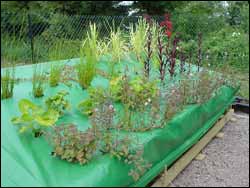GROWing the next generation of water recycling plants

The Green Roof Water Recycling System, GROW, will bring a splash of colour to the rooftops of office blocks and flats in cities across the UK. It will also help recycle water. The green membrane protects the system from rain, which itself could be collected and reused.
A vegetated rooftop recycling system has been developed that allows water to be used twice before it is flushed into the communal waste water system.
The Green Roof Water Recycling System (GROW) uses semi-aquatic plants to treat waste washing water, which can then be reused for activities such as flushing the toilet.
GROW is the brainchild of Chris Shirley-Smith, whose company Water Works UK is collaborating with Imperial College London and Cranfield University. The researchers are funded by the Engineering and Physical Sciences Research Council.
So-called grey water from washbasins, baths and showers is pumped up to the GROW system, which is constructed on the roof of an office or housing block. It consists of an inclined framework of interconnected horizontal troughs. Planted in these troughs are rows of specially chosen plants that gently cleanse the grey water. Trickling through the GROW framework, the plants’ roots naturally take up the dissolved pollutants, leaving ‘green water’. Green water is not drinkable and will be dyed with a vegetable colour to signify this, but it can be used to flush toilets or water the garden.
More than half the water used in the home and workplace does not need to be of drinkable quality yet it comes from the same pure source as our kitchen taps. Using GROW, much of the water that enters a building can be used twice before being placed into the national wastewater management system.
“We had to carefully choose which semi-aquatic plants to use. One of the most successful is water mint, whose roots have disinfectant qualities,” says Professor David Butler, who oversees the project at Imperial College. The other plant species include the yellow flag iris, marsh marigold, and the common reed. They are chosen to be resistant to the pollutants they absorb. By planting more than one species, the engineers guard against an unusually dirty batch of water exceeding a particular species’ tolerance level. Should one species die off, there will still be others there to continue the job until the dead plants can be replaced.
The beauty of the system is that it is not ‘high-tech’ in the traditional sense. “It does not require sophisticated maintenance, just tending, like any garden,” says Butler.
The next aim for GROW is to see if it can be reduced in size to sit above a household water butt, making it serviceable for individual households. The team will also investigate whether the addition of an ultraviolet light can enhance the disinfection of the water. They hope to market GROW commercially in the second half of 2006.
GROW is one project in a much larger EPSRC-funded Sustainable Water Management programme (WaND) that Professor Butler oversees at Imperial. “Our overall aim is to contribute towards sustainable water management in new developments. We hope that GROW will be one of the tools that can help us achieve that goal,” says Butler.
Media Contact
More Information:
http://www.epsrc.ac.ukAll latest news from the category: Ecology, The Environment and Conservation
This complex theme deals primarily with interactions between organisms and the environmental factors that impact them, but to a greater extent between individual inanimate environmental factors.
innovations-report offers informative reports and articles on topics such as climate protection, landscape conservation, ecological systems, wildlife and nature parks and ecosystem efficiency and balance.
Newest articles

Superradiant atoms could push the boundaries of how precisely time can be measured
Superradiant atoms can help us measure time more precisely than ever. In a new study, researchers from the University of Copenhagen present a new method for measuring the time interval,…

Ion thermoelectric conversion devices for near room temperature
The electrode sheet of the thermoelectric device consists of ionic hydrogel, which is sandwiched between the electrodes to form, and the Prussian blue on the electrode undergoes a redox reaction…

Zap Energy achieves 37-million-degree temperatures in a compact device
New publication reports record electron temperatures for a small-scale, sheared-flow-stabilized Z-pinch fusion device. In the nine decades since humans first produced fusion reactions, only a few fusion technologies have demonstrated…





















